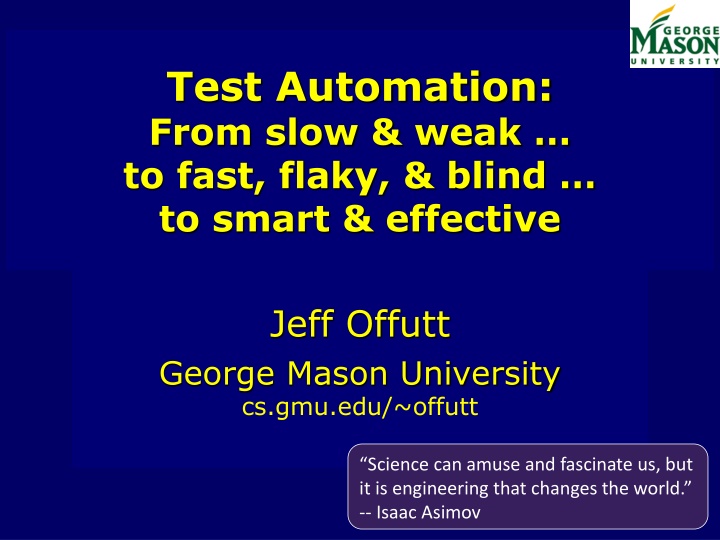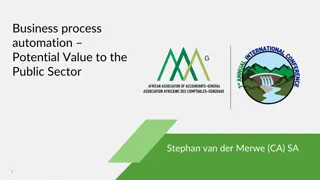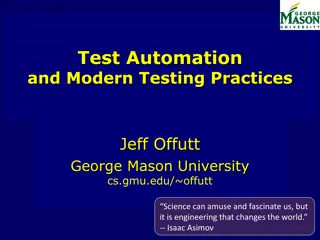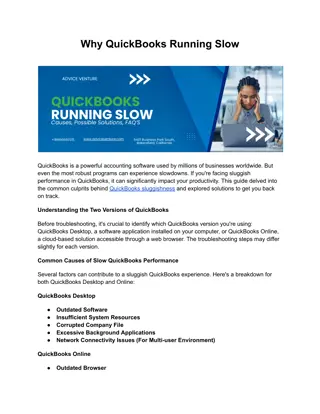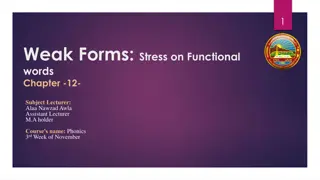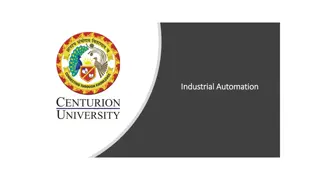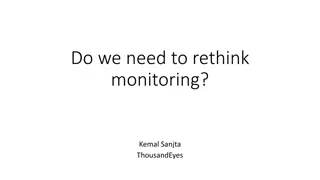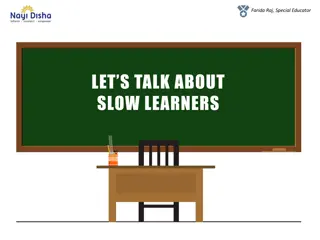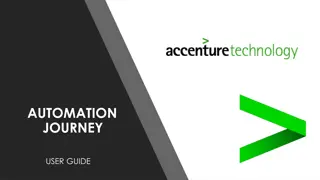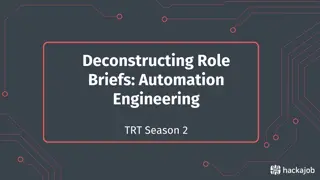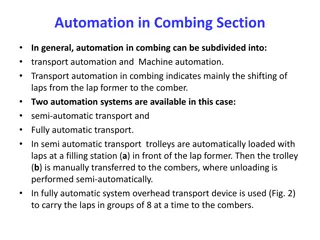Evolution of Test Automation from Slow & Weak to Fast, Flaky, Blind to Smart & Effective
Test automation has evolved over the years, with goals shifting from faster execution and repeatable results to embracing unit testing and automation for more modularity and efficiency. Challenges and achievements in test automation demonstrate the progress towards smarter and more effective testing practices.
Download Presentation

Please find below an Image/Link to download the presentation.
The content on the website is provided AS IS for your information and personal use only. It may not be sold, licensed, or shared on other websites without obtaining consent from the author.If you encounter any issues during the download, it is possible that the publisher has removed the file from their server.
You are allowed to download the files provided on this website for personal or commercial use, subject to the condition that they are used lawfully. All files are the property of their respective owners.
The content on the website is provided AS IS for your information and personal use only. It may not be sold, licensed, or shared on other websites without obtaining consent from the author.
E N D
Presentation Transcript
Test Automation: From slow & weak to fast, flaky, & blind to smart & effective Jeff Offutt George Mason University cs.gmu.edu/~offutt Science can amuse and fascinate us, but it is engineering that changes the world. -- Isaac Asimov
Test automation in the 1990s Goals for automating test execution Faster execution Repeatable results Fewer errors Mostly system testing Values generated by hand Results checked by hand (oracle) Capture-replay tools for GUIs Early unit-level test frameworks Assertions to check results JUnit integrated the best ideas and simplified test automation TA achievements major challenges & open problems takeaways of 37 2
Unit testing and automation Unit tests are easier to automate Thus more automation More modularity Less re-design Faster to produce Re-verification supports evolution Cheaper Less repetitive work Better software reduces support costs More predictable test automation TA achievements major challenges & open problems takeaways of 37 3
Then thisRoI for unit testing 60 Assume $1000 unit cost per fault, 100 faults 50 40 Fault origin (%) 30 Fault detection (%) 20 10 Unit cost (X) 0 Software Engineering Institute; Carnegie Mellon University; Handbook CMU/SEI-96-HB-002 test automation TA achievements major challenges & open problems takeaways of 37 4
Abstraction test design Model-based testing model / structure test requirements Abstract level (design) Concrete level (implementation) software artifact input values pass / fail test results test scripts test cases Offutt & Abdurazik, Generating tests from UML specifications, UML (Models), 1999 Ammann & Offutt, Introduction to Software Testing (2nd), 2018 test automation TA achievements major challenges & open problems takeaways of 37 5
An automated model-based test @Test Expected output (expected = ClassCastException.class) public void testMutuallyIncomparable () { List list = new ArrayList(); Prefix (setup) values list.add("cat"); list.add("dog"); Test case values list.add(1); Postfix values Object obj = Min.min(list); } abstract concrete test automation TA achievements major challenges & open problems takeaways of 37 6
Test automation categories model Test automation Execution Generation Management how what new test change test delete test test oracle prefix postfix values test values human-based human scripts prefix & postfix criteria-based C/R (GUIs) assembled pieces script languages frameworks (JUnit) test oracle continuous integration (DevOps) test automation TA achievements major challenges & open problems takeaways of 37 7
Achievements in test automation (generation) (1) mapping problem (abstract test to concrete test) test automation TA achievements major challenges & open problems takeaways of 37 8
Mapping examplevending machine Abstract test: [ 1, 3, 4, 1, 2, 4 ] Refined abstract test: Concrete test (mapping): 1. 2. 3. 4. 5. Testers implement abstract tests by hand But each transition maps to specific concrete actions Automate by assembling concrete test components Coin Coin 1 2 AddChoc, Coin, GetChoc, Coin, AddChoc GetChoc AddChoc AddChoc c= m&ms ; addChocolate(c); v= $1 ; addCoin(v); chooseChocolate(c); dispense(); v= $1 ; addCoin(v); c= m&ms ; addChocolate(c); Coin 3 4 GetChoc AddChoc or Coin AddChoc test automation TA achievements major challenges & open problems takeaways of 37 9
Mapping examplevending machine Abstract test: [ 1, 3, 4, 1, 2, 4 ] Refined abstract test: Concrete test (mapping): 1. 2. 3. 4. 5. Testers implement abstract tests by hand But each transition maps to specific concrete actions Automate by assembling concrete test components Coin Coin 1 2 AddWhiskey, Coin, GetWhiskey, Coin, AddWhiskey GetWhiskey AddWhiskey AddWhiskey w = Jameson; addIrishWhiskey(w); v= 2 ; addCoin(v); chooseIrishWhiskey(); dispense(); v= 2 ; addCoin(v); w = Jameson; addIrishWhiskey(w); Coin 3 4 GetWhiskey AddWhiskey or Coin AddWhiskey test automation TA achievements major challenges & open problems takeaways of 37 10
Assembling test components Test components Test 1 Test 2 C1 C1 C1 C2 C2 C3 C3 Test 3 C4 C4 C4 C5 C5 C5 C6 C6 C7 C7 Li & Offutt, Test Automation Language Framework for Behavioral Models, A-MOST 2015 test automation TA achievements major challenges & open problems takeaways of 37 11
Achievements in test automation (generation) (2) test oracles Briand, Di Penta, Labiche, Assessing and Improving State-Based Class Testing, TSE 2004 Barr, Harman, McMinn, Shahbaz, & Yoo, The Oracle Problem in Software Testing: A Survey, TSE 2015 test automation TA achievements major challenges & open problems takeaways of 37 12
1980s RIP model (fault & failure) Test Reaches Outputs Reachability (final program state) Fault Infection Infects Propagation Propagates Error program state Morell, A Theory of Fault-Based Testing, 1990 (PhD diss. 1984) Offutt, Automatic Test Data Generation (PhD diss. 1988) test automation TA achievements major challenges & open problems takeaways of 37 13
RIP model assumptions Implicit assumptions 1. A human tester looked at the output state 2. If the output was wrong, the tester saw it No false positives No false negatives common! assertions Test Outputs (final program state) If the assertion looks Reaches Reachability Infection Propagation Fault Infects Error program state Propagates test automation TA achievements major challenges & open problems takeaways of 37 14
RIPR model Outputs Test final program state Reaches Reachability Observed final output state Infection Fault Incorrect final output Propagation Infects Propagates Reveals Revealability Error program state Test oracles Li & Offutt, Test oracle strategies for model-based testing, TSE 2017 test automation TA achievements major challenges & open problems takeaways of 37 15
What makes a good test oracle? How do we model test oracles? Do test oracles need to observe the entire output space? Arbitrarily large Do test oracles need to observe intermediate states? Do test oracles always return the same answer? How do we automate test oracles when we do not know the correct output? Hundreds of results on these questions! test automation TA achievements major challenges & open problems takeaways of 37 16
Good test oracles are consistent Sometimes tests behave differently on different runs test A run 1 test A run 2 test A run 3 Google says 16% of their tests are flaky What makes a test flaky? Concurrency Asynchronous behavior Random inputs Resource leaks Test order dependency Collection class assumptions Relying on external systems Fowler, Eradicating non-determinism in tests, online 2011 Luo, Hariri, Eloussi, Marinov, An Empirical Analysis of Flaky Tests, FSE 2014 test automation TA achievements major challenges & open problems takeaways of 37 17
Good test oracles look Smoke (crash) tests miss about two-thirds of the failures Why waste a good test? Tests are expensive to design, to implement, and to run @Test (expected = NullPointerException.class) public void addOneValue() { list.addFront( cat ); Object obj = list.getFirst(); } ??? Should check: [ cat ] test automation TA achievements major challenges & open problems takeaways of 37 18
Good test oracles (TO) can see A blind test does not check the portion of the output that is incorrect @Test public void testTwoValues() { list.addFront( dog ); list.addFront( cat ); Object obj = list.getFirst(); assertTrue( Two values , obj.equals( cat )); } Passes: [ cat ] [ cat, cat ] [ cat, null ] Should check: [ cat, dog ] Up to 40% of industry automated tests are blind Li & Offutt, Test oracle strategies for model-based testing, TSE 2017 Baral & Offutt, An Empirical Analysis of Blind Tests, ICST 2020 test automation TA achievements major challenges & open problems takeaways of 37 19
Achievements in test automation (management) (3) test evolution (smart tests) test automation TA achievements major challenges & open problems takeaways of 37 20
Pre-automated tests Scripts with human generated values are slow! error prone! have limited repeatability! almost impossible to integrate criteria These tests are primitive single-cell organisms test automation TA achievements major challenges & open problems takeaways of 37 21
Modern not-smart automated tests Test values Created by a mix of humans and test data generators Satisfy well-documented goals, test criteria, or specialized domain needs Integrated into automated test scripts (eg, JUnit) Includes a small amount of brain power these tests know what results to expect (eg, assertions) Fast repeatable These multi-cellular tests show preliminary signs of intelligence test automation TA achievements major challenges & open problems takeaways of 37 22
Multicellular test model But a modern test does not know prefix values test values postfix values Why is it there? expected results When should it run? When should it change? When should it die? Baral, Offutt, & Mulla, Self determination: A comprehensive strategy for making automated tests more effective and efficient, ICST 2021 test automation TA achievements major challenges & open problems takeaways of 37 23
Intelligent tests Intelligent tests need self-awareness and self-determination! Each test should encode traceability what it covers Tests should check what changed in the software, and rerun if needed Tests should alert tester and ask for a change when they no longer match Tests should delete themselves when no longer needed test automation TA achievements major challenges & open problems takeaways of 37 24
Code evolutiontest changes Changed method Original method concatNames (s1, s2) fName = s1 lName = s2 return lName+ +fName concatNames (s1, s2) fName = s1 lName = s2 return fName+ +lName Changed test Original test testConcatNames (s1, s2) result = concatNames( Anita , Borg ) assertTrue(result == Borg Anita ) testConcatNames (s1, s2) result = concatNames( Anita , Borg ) assertTrue(resultContains( Anita ) && (result.contains( Borg )) test automation TA achievements major challenges & open problems takeaways of 37 25
Seven challenges and problems in test automation test automation TA achievements major challenges & open problems takeaways of 37 26
The Web changed everything High quality become essential reliability, usability, maintainability, Distribution became free web deployment Support became cheap we search the Web Continuous updates perfect out of the box is outdated The Web and agile processes resuscitated evolutionary design Evolutionary design requires continuous (automated) testing test automation TA achievements major challenges & open problems takeaways of 37 27
TA challenges and problems (1) Non-determinant software We cannot know the result a priori Examples: Games, scientific modeling, non-deterministic, AI & ML, How to build automated tests? Inputs are often very complicated Test oracles JUnit assertions are not enough Metamorphic testing is a great idea but we need more Instead of correct behavior, we need acceptable behavior test automation TA achievements major challenges & open problems takeaways of 37 28
TA challenges and problems (2) Test oracles We need to automate generation TOs are still usually created by hand Old, current, and new approaches: Formal specifications lots of research, but limited use Aggregating unit-level TOs into system-level TOs Impact analysis to identify which parts of output state to check Screen capturing approaches Machine learning to guess expected results? Leverage TDD tests to create expected results for similar tests? Mutate test values, then design corresponding TO mutations? test automation TA achievements major challenges & open problems takeaways of 37 29
TA challenges and problems (3) Testing mobile apps Many details are very different Test automation tools (execution) are very slow Most inputs are through the screen with funny gestures and auto-fills Challenging to automate Every mobile device has its own ecosystem How to model these ecological communities? How to test entanglements with other apps? What does a test oracle look like in a mobile app? test automation TA achievements major challenges & open problems takeaways of 37 30
TA challenges and problems (4) Non-behavioral properties We need effective techniques to automate the testing of non-behavioral properties Timeliness automatic execution of timely tests is complex Accuracy if software approximates a solution, how can we evaluate how accurate its results are? Usability human studies are usually done by hand can we create a model that can empower automation? Ethical and equitable behavior can we define this generally and specifically enough to empower automation? test automation TA achievements major challenges & open problems takeaways of 37 31
TA challenges and problems (5) Smart tests We have only scratched the surface Can the smart test approach be expanded to arbitrary models and other coverage criteria? Can NLP be used to connect requirements to code? How to build a full test framework where tests are truly self-aware? Agent-based software might be an effective model Can such a framework be fully implemented into an IDE? test automation TA achievements major challenges & open problems takeaways of 37 32
TA challenges and problems (6) IDE-integrated testing Tests should run when we compile When I learned to program compile integrate link run repeat Each step took multiple iterations as automated tools (compilers, IDEs, make) helped us find problems IDEs should treat behavioral checking exactly the same as syntax and semantics checking Compile integrate generate tests generate TOs run tests And the IDE should use automatic program repair to automatically fix some faults test automation TA achievements major challenges & open problems takeaways of 37 33
TA challenges and problems (7) Automatic program repair Tests identify failures More failing tests help APR especially if they are different Can we automatically create more failing tests ? Automatic localization is still challenging How to localize faults that span multiple statements ? How to localize faults that require structural changes ? Automatic repair techniques are still rudimentary Mutants are limited to simple changes How can we model more complex changes ? Are tests comprehensive enough to validate proposed repairs ? test automation TA achievements major challenges & open problems takeaways of 37 34
Takeaways (1) Test automation has enormous impact test scripts test oracle continuous integration JUnit capture replay agile & TDD Model- based testing test suite management test automation TA achievements major challenges & open problems takeaways of 37 35
Takeaways (2) Good models empower good research ^ test model / structure requirements Execution Generation Management Abstract level how what new test change test delete test Concrete level software artifact values test oracle prefix postfix input values test values human-based human scripts pass / fail test results test scripts test cases prefix & postfix criteria-based C/R (GUIs) script languages assembled pieces frameworks (JUnit) test oracle continuous integration Outputs Test final program state prefix values Reaches Observed final output state Incorrect final state Fault test values expected results postfix values Infects Error program state Propagates Reveals Test oracles test automation TA achievements major challenges & open problems takeaways of 37 36
Takeaways (3) We have barely started! Every single research result reveals two more problems we need to solve Computer science amuses and fascinates us, but automation changes the world. (paraphrasing Isaac Asimov) Jeff Offutt cs.gmu.edu/~offutt test automation TA achievements major challenges & open problems takeaways of 37 37
